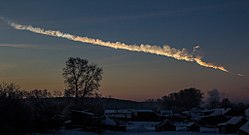 2005 WK4 imaged 30 times by radar at Goldstone on 8 August 2013 | |
| Discovery [1] [2] | |
|---|---|
| Discovered by | Siding Spring Srvy. |
| Discovery site | Siding Spring Obs. |
| Discovery date | 27 November 2005 |
| Designations | |
| (277475) 2005 WK4 | |
| 2005 WK4 | |
| Apollo · NEO · PHA [1] [2] | |
| Orbital characteristics [1] | |
| Epoch 4 September 2017 (JD 2458000.5) | |
| Uncertainty parameter 0 | |
| Observation arc | 8.71 yr (3,180 days) |
| Aphelion | 1.2506 AU |
| Perihelion | 0.7707 AU |
| 1.0106 AU | |
| Eccentricity | 0.2374 |
| 1.02 yr (371 days) | |
| 81.040° | |
| 0° 58m 12.36s / day | |
| Inclination | 9.8433° |
| 138.14° | |
| 74.063° | |
| Earth MOID | 0.0037 AU ·1.4 LD |
| Physical characteristics | |
| Dimensions | 0.25±0.05 km [a] 0.284 km (calculated) [3] |
| 2.595±0.002 h [4] 2.7±0.1 h [a] 2.73±0.05 h [5] | |
| 0.20 (assumed) [3] | |
| S k [6] · S (assumed) [3] B–V = 0.677±0.025 [6] V–R = 0.446±0.019 [6] V–I = 0.750±0.024 [6] | |
| 20.1 [1] [3] | |
(277475) 2005 WK4, provisional designation 2005 WK4, is a stony, sub-kilometer asteroid, classified as near-Earth object and potentially hazardous asteroid of the Apollo group that passed Earth within 8.2 lunar distances on 8 August 2013. [7] It was discovered on 27 November 2005, by astronomers of the Siding Spring Survey at Siding Spring Observatory, Australia. [2]


